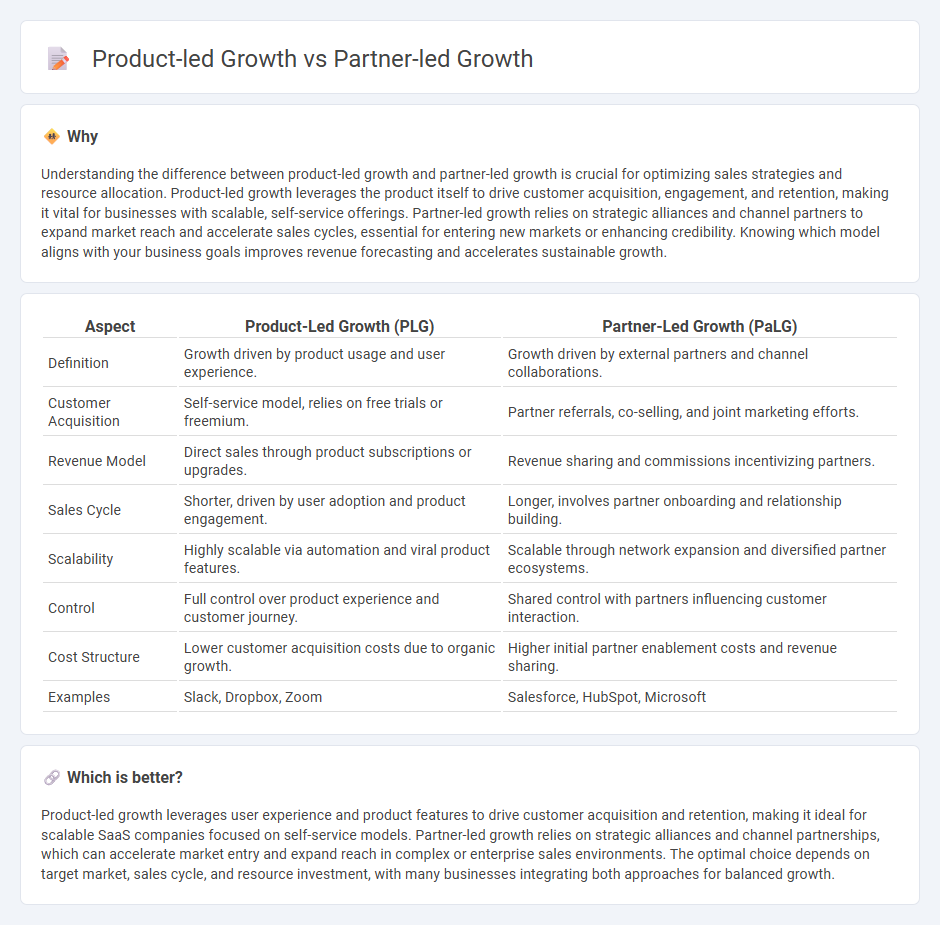
Sales strategies often revolve around product-led growth, where customer acquisition and retention are driven by the product's value and user experience, fostering organic expansion through user engagement. Partner-led growth emphasizes collaboration with external partners, leveraging their networks and resources to scale sales and market penetration effectively. Explore the distinct benefits and implementations of product-led versus partner-led growth to optimize your sales approach.
Why it is important
Understanding the difference between product-led growth and partner-led growth is crucial for optimizing sales strategies and resource allocation. Product-led growth leverages the product itself to drive customer acquisition, engagement, and retention, making it vital for businesses with scalable, self-service offerings. Partner-led growth relies on strategic alliances and channel partners to expand market reach and accelerate sales cycles, essential for entering new markets or enhancing credibility. Knowing which model aligns with your business goals improves revenue forecasting and accelerates sustainable growth.
Comparison Table
| Aspect | Product-Led Growth (PLG) | Partner-Led Growth (PaLG) |
|---|---|---|
| Definition | Growth driven by product usage and user experience. | Growth driven by external partners and channel collaborations. |
| Customer Acquisition | Self-service model, relies on free trials or freemium. | Partner referrals, co-selling, and joint marketing efforts. |
| Revenue Model | Direct sales through product subscriptions or upgrades. | Revenue sharing and commissions incentivizing partners. |
| Sales Cycle | Shorter, driven by user adoption and product engagement. | Longer, involves partner onboarding and relationship building. |
| Scalability | Highly scalable via automation and viral product features. | Scalable through network expansion and diversified partner ecosystems. |
| Control | Full control over product experience and customer journey. | Shared control with partners influencing customer interaction. |
| Cost Structure | Lower customer acquisition costs due to organic growth. | Higher initial partner enablement costs and revenue sharing. |
| Examples | Slack, Dropbox, Zoom | Salesforce, HubSpot, Microsoft |
Which is better?
Product-led growth leverages user experience and product features to drive customer acquisition and retention, making it ideal for scalable SaaS companies focused on self-service models. Partner-led growth relies on strategic alliances and channel partnerships, which can accelerate market entry and expand reach in complex or enterprise sales environments. The optimal choice depends on target market, sales cycle, and resource investment, with many businesses integrating both approaches for balanced growth.
Connection
Product-led growth leverages the product itself as the primary driver of customer acquisition and retention, emphasizing user experience and value delivery. Partner-led growth complements this approach by expanding market reach through strategic alliances, enabling co-selling and leveraging partner networks to boost sales. Together, these growth models create a synergistic effect, where product excellence attracts users and partner collaborations scale distribution efficiently.
Key Terms
Channel Partners
Partner-led growth leverages channel partners to expand market reach, boost sales, and enhance customer relationships through collaborative strategies and shared goals. This approach emphasizes partner enablement, joint marketing, and co-selling to accelerate revenue and scale, particularly in complex or enterprise markets. Explore how channel partners can transform growth trajectories by driving adoption and unlocking new opportunities.
User Acquisition
Partner-led growth leverages strategic collaborations with external organizations to access new user bases, enabling scalable user acquisition through established partner networks. Product-led growth emphasizes the product as the primary driver of user acquisition, relying on user experience, self-service onboarding, and viral features to attract and retain users. Explore how these growth strategies impact user acquisition to optimize your market expansion efforts.
Co-Selling
Partner-led growth leverages strategic alliances where companies collaborate with partners to co-sell solutions, enhancing market reach and accelerating revenue streams. Product-led growth centers on the product itself driving acquisition and retention through user experience and self-service models, reducing reliance on traditional sales teams. Explore deeper insights into how co-selling strategies impact growth dynamics in both approaches.
Source and External Links
Unlocking Success: The Power of Partner-Led Growth - Partner-led growth places collaboration and alliances at the forefront of an organization's strategy, leveraging external partnerships to drive business development, innovation, and sustained growth.
The rise of Partner-Led Growth: 66% of companies leverage indirect ... - Partner-led growth is a strategy where companies rely on external partners--such as channels, ecosystem, referrals, and resellers--to drive sales, expand market reach, and accelerate revenue.
A CRO's guide to partner-led growth - Partner-led growth is a comprehensive approach to scaling a business by building and leveraging ecosystems of partnerships, which can significantly improve customer retention and fuel revenue growth.
 dowidth.com
dowidth.com